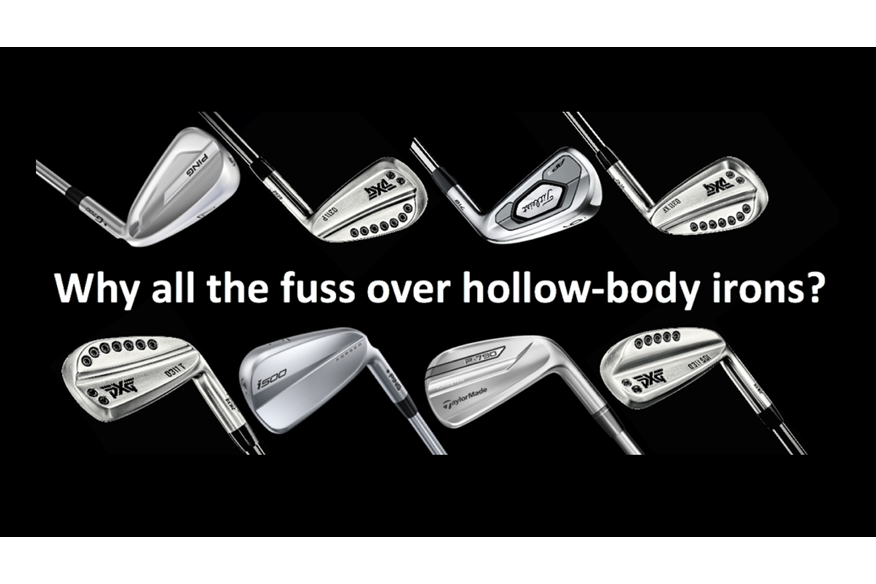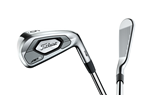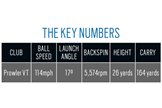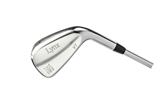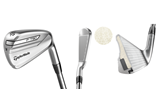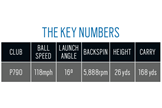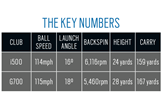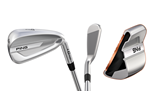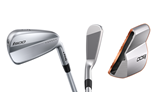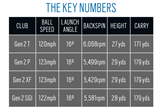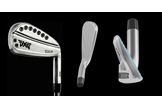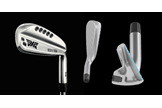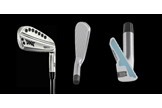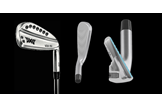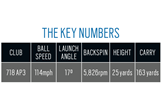TESTED: Hollow body irons
Last updated:
With the exception of all the new drivers, hollow-body irons have been the hottest equipment launch of the last 12 months.
They weren’t new when PXG introduced their first model in 2015; TaylorMade made some in the 1990s. But PXG’s thinking lit up a whole new product category – and now all the major brands bar Callaway and Mizuno are getting in on the hollow-headed act.
The idea is simple; a hollow iron head (made in two pieces) gives club designers new options when it comes to looks, spin and forgiveness, which can’t be done with traditional blades or cavity backs. It means golfers get sleeker heads, but with extra playability. TaylorMade, Ping, Titleist and Lynx have all jumped on the hollow-body bus and come at hollow heads in different ways, so with their popularity rising faster than this summer’s soaring temperatures, we felt the time was right to find out how they all compare.
How we did it:
We asked each brand that makes hollow-body irons to send us a sample 7-iron matched to our test pro Ben Frost’s swing. He hit each in turn, while our launch monitor watched on gathering data. Miss-hits were removed before we analysed the data to see how each iron compared.
Review: Ping i500 and G700 iron
You need to know:
Ping came at hollow heads slightly differently to most brands, who use hollow tech to make more forgiving better player irons. Ping started at the opposite end of the scale and produced a good-looking super game improvement model (the G700) before introducing the i500 players’ distance iron eight months later.
Essentially, the face in both the i500 and G700 is made from the same maraging steel used in their fairways and hybrids, but the i500’s face is forged. There’s no mention of tungsten weighting or foam/elastomer inside either head.
Ping i500 iron details:
RRP: £149 (s) £159 (g) / Availability: 3-PW, UW / Stock shaft: Choose from 10 premium options / 7-iron loft: 30.5° / Category: Better player
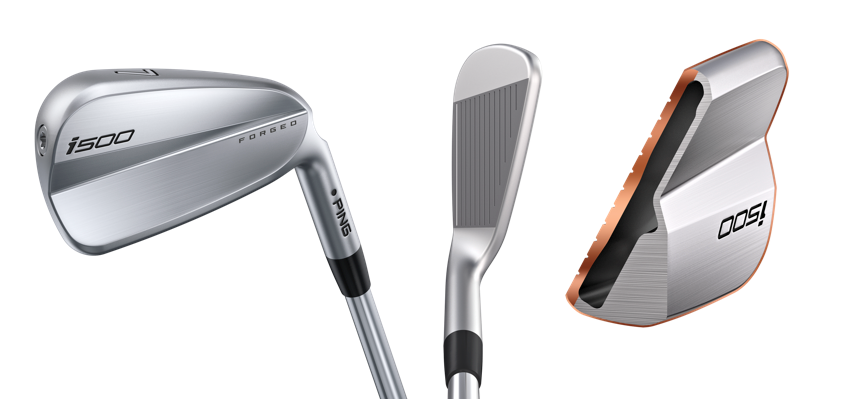
Review: Ping i500 iron verdict
Irrespective of how i500 performs, it’s the best-looking iron Ping have ever made in our eyes. It really is gorgeous. Gone is any hint of the, long boxy head which has been Ping’s trademark for years, and in its place is just the sort of profile (low offset, compact size with a thin top edge and reasonable sole width) that decent club golfers will love.
Compared to Ping’s other new iron (the cavity back i210, which costs £23 per club less) i500 offers similar levels of forgiveness, but is capable of producing 3mph faster ball speeds and 7-8 yards more carry with a 7-iron. We’d say i500 is a brilliant choice for any reasonable ball striker who wants to maximise iron distance, in a players-shaped head.
We’re big fans of Ping’s fitting heritage and how you get to choose from 10 premium shafts at no extra cost, and because clubs are priced individually you only need buy what you intend to use.
Full Ping i500 iron review here
Review: Ping i500 and G700 iron data
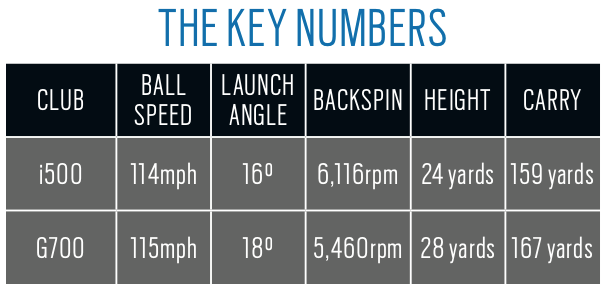
Ping G700 iron details:
RRP: £149 (s) £159 (g) per club / Availability: 4-PW, UW, SW / Stock shaft: Choose from 10 premium options / 7-iron loft: 29.5° / Category: Super game improvement
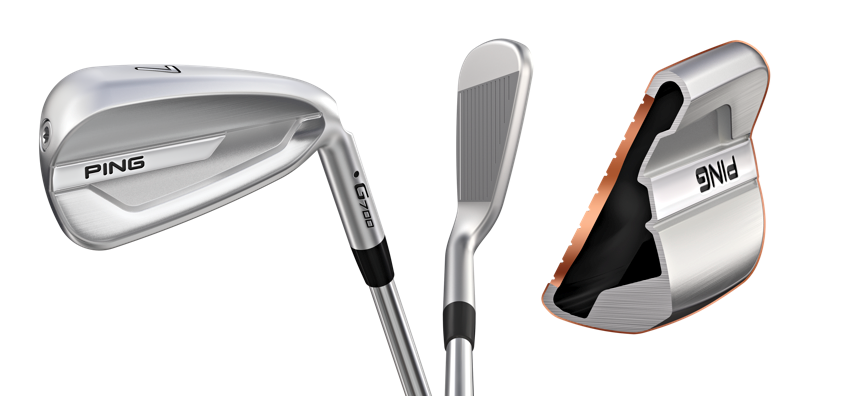
Review: Ping G700 iron verdict
As the most forgiving and longest iron in Ping’s range (bigger heads mean more face flex and ball speed) the G700 has pretty broad shoulders. Where before super game improvement irons were chunky in all the wrong places, G700 is sleek and desirable. SGI irons never used to look this good.
By launching shots higher than any other iron and peaking shots out among the highest on test, with low spin, it’s no surprise the G700 recorded very solid carry distance numbers and gained eight yards over the i500.
As with all hollow-body irons, they come at extra expense over cavity backs, and that’s because the heads are produced in two pieces, which ramps up the costs. There’s lots of average golfers out there who’ve wanted a great-looking, game-improving iron for years, but haven’t wanted to give up any forgiveness or playability to get it.
In our opinion G700 does exactly that; you won’t find a better-looking SGI model out there.
Full Ping G700 iron review here
Review: Titleist 718 AP3 iron
You need to know:
The 718 AP3 took golfers by surprise when it arrived last autumn, primarily because traditional Titleist aren’t generally the quickest adopters of new tech trends. AP3 rolls together everything Titleist have learnt from their AP1 and AP2 irons over the years.
A player-preferred shape offers forgiveness and a hollow head with fast face construction is “precise when you pure it and forgiving when you don’t”. Tungsten toe and heel weighting increases off-centre hit forgiveness. No part of the head is forged.
Titleist 718 AP3 iron details:
RRP: £150 (s) £175 (g) per club / Availability: 3-PW, AW / Stock shaft: True Temper AMT Black plus a choice of 43 premium options / 7-iron loft: 31° / Category: Better player
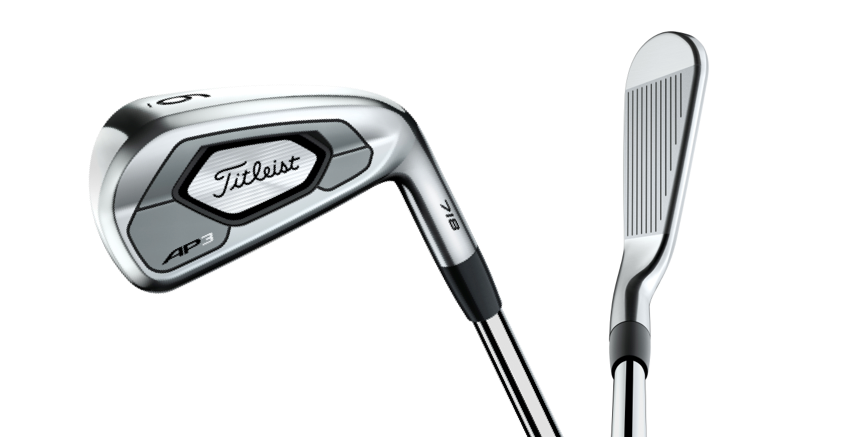
Review: Titleist 718 AP3 iron data
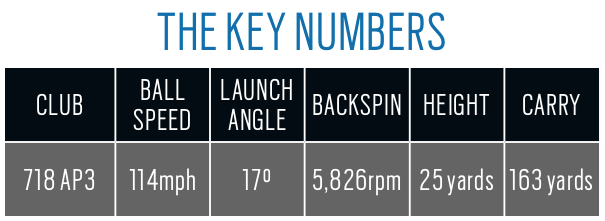
Review: Titleist 718 AP3 iron verdict
The best Titleist iron for years. Just like the TaylorMade and Ping i500, the AP3 is a beautiful golf club that bridges the gap perfectly between the better player models so many golfers yearn for and game improvement designs we know we should be using. Our test pro’s data spells out decent levels of backspin, which as Titleist promised would mean approach shots stop on the green. If you’re a player on the lookout for a new set, but don’t want to stretch to PXG price levels, AP3 should be on your shortlist right alongside the TaylorMade P790 and Ping i500.
TESTED: Titleist Pro V1 vs Mail order golf balls
Review: Lynx Prowler VT iron
You need to know
The Prowler VT is Lynx’s first crack at a modern hollow iron. It has a two-piece construction with forged face and cast body. We tested the VT earlier in the year and said its set-up means it can be seen as a playable blade. There’s no mention of any tungsten weighting or foam filling.
Everything you need to know about shaft weight and why it’s now more important than flex
Lynx Prowler VT iron details:
RRP: £599 / Availability: 4-PW (5-PW stock set) / Stock shaft: KBS Tour / 7-iron loft: 32° / Category: Better player
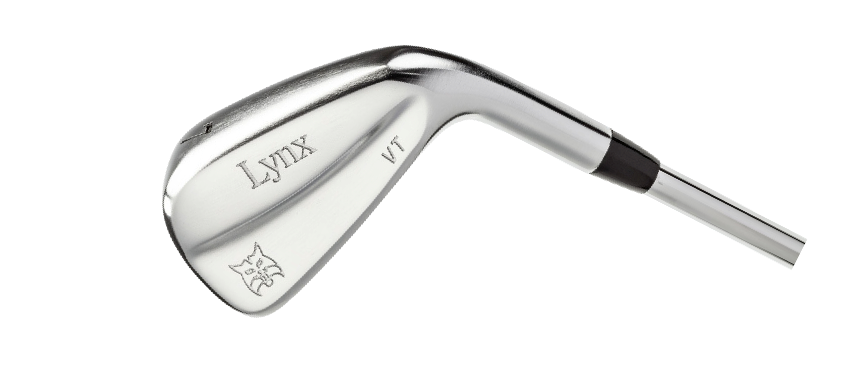
Review: Lynx Prowler VT iron data
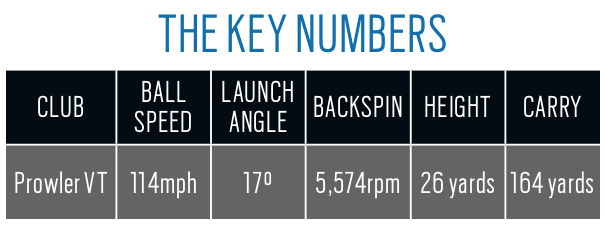
Review: Lynx Prowler VT iron verdict
Plenty of golfers won’t even realise the simple, classically designed VT has a hollow body, which shows just how sleek and unassuming hollow can be. The VT made it into our Top 10 Better Player irons of 2018, not because it was the most forgiving or longest, but because it looks great, comes with decent components and is half of the price of the competition. None of that has changed.
From the joint weakest loft of all the irons (#7) we tested, it produced solid ball speed, backspin and carry numbers. It wasn’t quite as forgiving as some, but for golfers who want a reasonably-priced, but credible alternative to a set of blades, they’re worth seeking out.
Full Lynx Prowler VT review here
Review: PXG 0311 Gen 2 T / P / XF / SGI
You need to know:
PXG started the march which has now become a dash towards hollow irons, and because they’re an ultra-premium brand, every iron in the line-up is forged. They believe it’s the only way the best feel, sound and feedback can be guaranteed, irrespective of a golfer’s ability. The inside of every iron is CNC milled, which very precisely and consistently positions mass.
PXG also boast of producing the thinnest face available (just 1.5mm of HT1770 maraging steel) which, along with the COR 2 material inside each head, dampens vibrations but also gives an explosive COR, which PXG say improves ball speed by 1-2mph. Tungsten weights around the perimeter of each iron head raise MOI and optimise launch conditions. A 4-PW set starts from £3,200…
PXG 0311 Gen 2 iron details:
T: RRP: From £400 per club Availability: 3-PW 7-iron loft: 32° Category: Tour
performance
P: RRP: From £400 per club Availability: 3-PW, GW 7-iron loft: 31° Category: Players
XF: RRP: From £400 per club Availability: 3-PW, GW, SW, LW 7-iron loft: 30°
Category: Game improvement
SGI: RRP: From £400 per club Availability: 3-PW, GW, SW, LW 7-iron loft: 29°
Category: Super game improvement
Review: PXG 0311 Gen 2 T iron
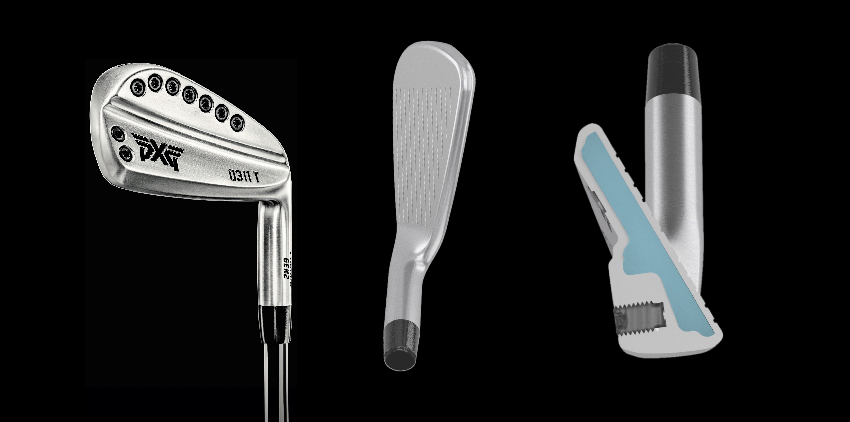
Review: PXG 0311 Gen 2 T iron verdict
“T” stands for Tour Performance, but don’t think all PXG players use it. Zach Johnson rocked up to The Open with a set of Ts, but Pat Perez used a set of XF irons. PXG like to fit irons to your attack angle. If you hit down (like some tour players) you’ll see the benefits of the T’s thinner sole. But for shallower attack angles a wider sole model can be a great option.
T was our test pro’s best fitting PXG model, and even though its MOI forgiveness is lower, he hit it into the tightest dispersion circle of any iron we tested. As the weakest loft it’s no surprise the T lost a bit of ball speed and carry and span a bit more than the other PXG models. But it’s still a cracking, compact performance iron.
Full PXG 0311 T Gen 2 iron review here
Review: PXG 0311 Gen 2 P iron
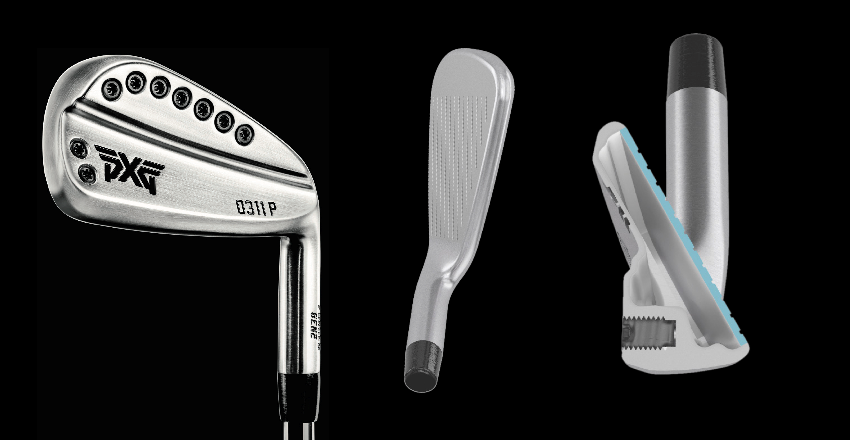
Review: PXG 0311 Gen 2 P iron verdict
The original version of the “P” iron can lay legitimate claim to being the iron that reinvented the iron, as it brought the spotlight firmly on to the benefits of hollow heads. We completely understand that many golfers won’t stomach the cost of PXG, and that’s fine. But we wouldn’t be doing our job if we turned a blind eye to PXG’s seriously strong performance in this test.
For our test pro the P and XF were the fastest and longest irons here, producing identical numbers (in the same shaft) for ball speed, launch, backspin, height and carry. That can only be described as a seriously impressive, if expensive, display.
Review: PXG 0311 Gen 2 T / P / XF / SGI data
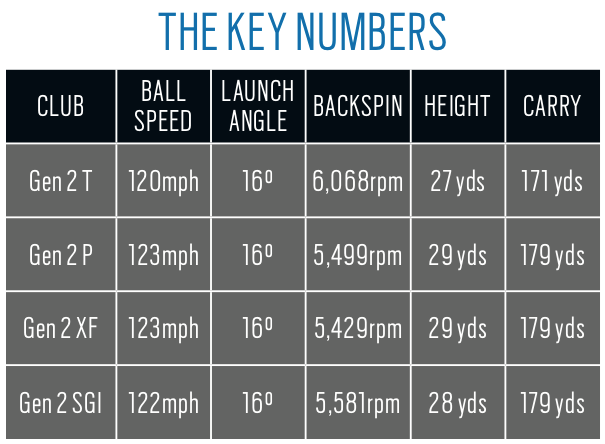
Review: PXG 0311 Gen 2 XF iron
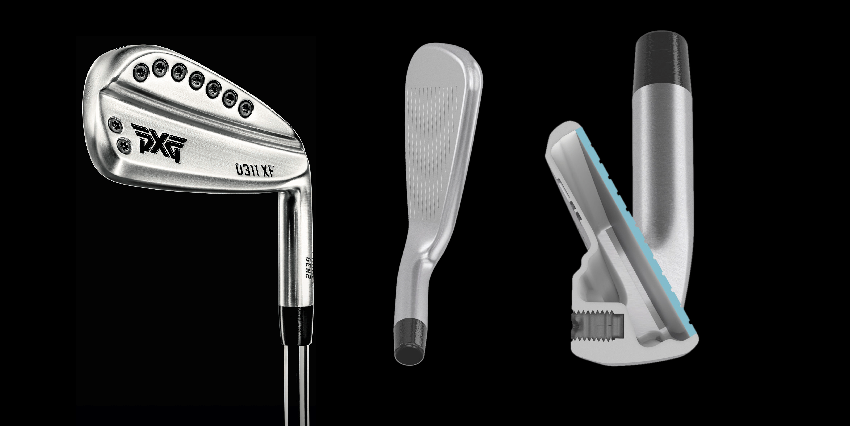
Review: PXG 0311 Gen 2 XF iron verdict
XF stands for Xtreme Forgiveness and while some golfers poke fun at PXG’s countless tungsten weight screws scattered around the edges of their irons, the tech is obviously working. Just like the P, XF is a seriously strong performer, and its bigger but still great looking head will suit tons of club golfers’ eyes.
PXG couldn’t possibly have known back in 2015 when they launched their first iron how they’d force other brands to develop hollow heads, but that’s what happened. And thanks to hollow models offering more desirable looks and extra forgiveness over traditional irons, there’s every chance they’re here to stay.
Review: PXG 0311 Gen 2 SGI iron
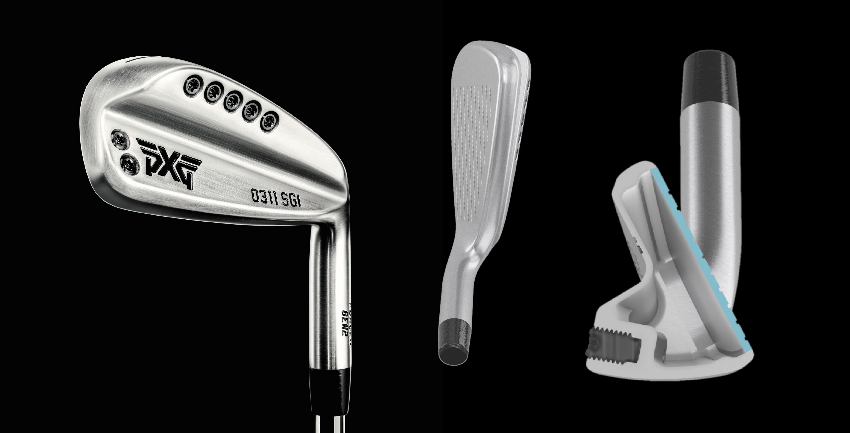
Review: PXG 0311 Gen 2 SGI iron verdict
You won’t find many forged super game improvement irons, but we love PXG’s thinking of not seeing a golfer’s ability as a hurdle to how an iron should sound or feel. PXG want to put only the best clubs they can make into a player’s hands, irrespective of handicap. So unlike lots of SGI irons in the past, these SGIs are unashamedly premium and certainly not lower spec when it comes to components.
The long, low profile head (from toe to heel) and wide round sole, with the iron’s back visible at address, won’t be everyone’s cup of tea. But for golfers who need as much help as they can get to push shots out there, they’re something else.
Review: TaylorMade P790 iron
You need to know:
The P790s arrived last August, and they’ve been a huge success. TaylorMade has sold tons of them, while lots of tour players have put P790 long irons in their bags. There’s a forged face (with a cast body) and high-density tungsten plugs in the long and mid irons (3-7) which means added forgiveness and precise positioning of the CG.
“Speedfoam” is injected into the head to support the thin face and help manage vibrations and improve sound, feel and feedback. It has the look and feel of a true players’ iron, but with the forgiveness and playability of a perimeter weighted iron.
TaylorMade P790 iron details:
RRP: £1049 (s) £1299 (g) Availability: 3-PW Stock shaft: True Temper Dynamic Gold 105 (s) UST Recoil 760/780 (g) 7-iron loft: 30.5° Category: Better player
Review: TaylorMade P790 iron
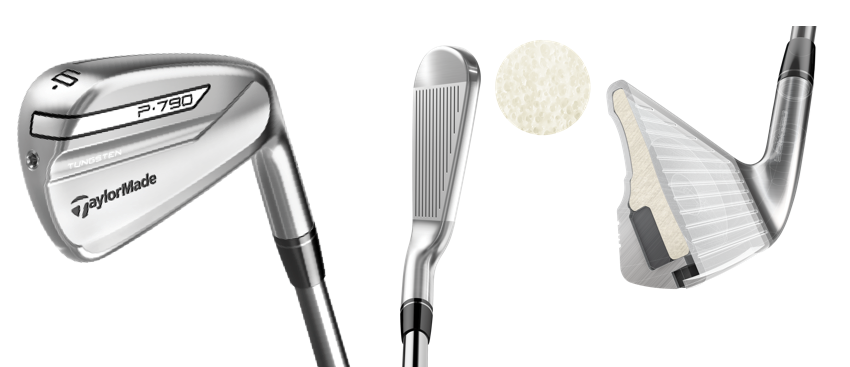
Review: TaylorMade P790 iron data
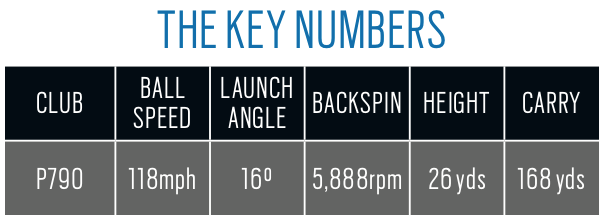
Review: TaylorMade P790 iron verdict
We’ve tested the P790 on numerous occasions and it consistently comes up trumps. First-off it’s a great looking head with a profile and shape many golfers would liken to a traditional blade. But it’s pumped full of performance-enhancing tech, which could never be packed into a muscleback model.
Our test really wasn’t about distance, primarily because there are very different models (aimed at different types of golfers) included, so it would be misleading to recommend one model over another. But the P790 is fast and forgiving and in our eyes sits right on the fence between better player and game improvement models.
Our test pro said the Speedfoam inside the head, like the PXG COR 2 material, adds up to a nicer overall sound and feel over the unfilled models. If you’re looking at hollow irons more closely, they definitely should be on your radar. It’s worth remembering that along with the Lynx the P790s are the only irons here supplied as a set; the others come as individual clubs, which is worth bearing in mind.
Full TaylorMade P790 review here
FOUR THINGS WE LEARNED DURING THIS TEST…
1: PXG irons are very, very good.
They cost a lot and many golfers will never understand why people pay that price. But PXG’s 2018 iron line-up is the real deal. Billionaire owner Bob Parsons’ business plan has never been to be the biggest golf equipment brand; he’s obsessed with being the best. And when it comes to hollow irons, our data certainly supports that thinking.
2: Hollow irons really could be the future.
What started as a trickle has now become a flood, and because Ping and PXG are showing that hollow heads can be for everyone, we believe they’ve got a bright future – even though they’re more costly to produce. We’re already trying to figure out which brand will be next to join the hollow party… Mizuno, perhaps? You heard it here first…
3: Angle of attack is really important.
How PXG like to fit irons offers a perfect explanation. They look at how golfers present the iron to the ball at impact. So players who hit down and catch the ball first usually fit narrower soles better (because a wide sole hits and bounces off the turf), whereas shallower attack angles are often better suited to wider soles.
4: Hollow irons are for everybody.
In the early days, hollow irons were seen as a way to make better looking, more forgiving players irons. But right now there are models out there to suit all standards of golfer. Like woods and hybrids – which are hollow and very forgiving – we reckon golfers might look back in a few years and wonder where all the cavity back irons went…
